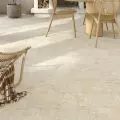The article is from A&B issue 7-8|23
The debate on colonialism and now decolonization, which has been going on around the world for several years, has now reached architectural forums. Its manifestation is the 18th Venice Architecture Biennale. "Laboratory of the Future" shows the latest trends, from which we ourselves, and we ourselves, can derive a story of what lies ahead - both in terms of architecture, culture, environment and social trends. And this is thanks to the bold visions and unprecedented ideas of the curator of this year's Biennale - Ghanaian and Scottish-born architect, professor and writer Lesley Lokko.
The 18th Venice International Architecture Exhibition is open until November 26, 2023.
Africa is a laboratory of the future. [...] We are the continent with the youngest population in the world, the fastest urbanizing, growing at a rate of four percent at the expense of local ecosystems - so we are also at the forefront of climate change. Yes, the program focuses on Africa, but we're not just talking about Africa - we're using it as a place to try to understand everything and everywhere. After all, the Biennale itself is a laboratory of the future - Lesley Lokko
Lesley Lokko - curator of this year's Biennale, a Ghanaian and Scottish-born architect, professor and writer
Photo: Jacopo Salvi
Thanks to her, the Venice Biennale has become an extraordinary three-dimensional guide to traditional and vernacular architecture, local community cultures, folklore and ecosystems around the world, especially faraway (from Europe) lands. No need to fly planes from continent to continent (and emit noxious gases), the Venice Biennale allows you to learn about projects created by less privileged architects and architects, to learn about the processes of exploitation and marginalization to which colonized communities were subjected, to understand that today's inequalities are often the result of colonial legacies.
center of the future
"Laboratory of the Future," the main exhibition in the Arsenal buildings and the Central Pavilion at Giardini, presents eighty-nine female artists, more than half of them from Africa. Divided into six sections, the exhibition responds to the most important challenges of modern times: "Force Majeure" is a presentation of architectural offices from Africa or the African diaspora, such as Kéré Architecture and Adjaye Associates. Other sections include "Dangerous Liaisons" and displays divided into four sections: Food, Agriculture and Climate Change; Gender and Geography; Mnemonic; Visitors from the Future.
Lokko stresses that he puts Africa in the spotlight because "Africa is the laboratory of the future. [...] We are the continent with the youngest population in the world, the fastest urbanizing, growing at a rate of four percent at the expense of local ecosystems - so we are also at the forefront of climate change. Yes, the program focuses on Africa, but we're not just talking about Africa - we're using it as a place to try to understand everything and everywhere. After all, the Biennale itself is a laboratory of the future."
"Counteract" exhibition by Kéré Architecture studio as part of the "Force Majeure" exhibition, a presentation of architectural offices from Africa or the African diaspora
photo: Matteo de Mayda
With the sensitivity of the younger generation to climate change, the catalog of destruction (and the grim vision of the future) shown in some exhibitions can be downright traumatic for many. Fortunately, they are offset by a positive message - countless examples of fantastic projects and solutions to the dangers of the modern world.
Does the Biennale offer visions of the future? Not necessarily. Many exhibitions are based on history or research and current projects on a smaller scale. Is it a true "Laboratory of the Future"? Not necessarily, but it's up to us what we do with the knowledge we acquire while visiting the exhibitions. However, it is an important step for the world as a whole, and especially for countries that so far have not had the opportunity to speak up for their own cause and present their achievements themselves.
"Kwaeε" installation by Adjaye Associates, pro: Sir David Adjaye
photo: Andrea Avezzù
There's more news at this year's Biennale- for the first time ever, the College Architettura Biennale has been opened, where professionals and specialists will work with students andarchitecture students, young female architects and architects from around the world, and teach classes on architecture in the broadest sense, sensitizing inequality and post-colonialism.
"Carnival," on the other hand, is a six-month program of public events, a space for the exchange of opinions and views for a dialogue between politicians and politicians, artists and artists, activists and activists with female architects and architects, scientists and scientists, female students and students. This intersectional form of activities is intended to bring together many professional groups and bridge the gap between female architects and the public.
This year, there are virtually no flyers at the exhibitions. Visitors finally do not get physically tired while lugging kilograms of printed paper.
Nordic Pavilion - "Girjegumpi: The Sámi Architecture Library," curated by Carlos Mínguez Carrasco and James Taylor-Foster (ArkDes).
Photo: Matteo de Mayda
multi/nationalism
For years, national pavilions in Venice have been criticized as an outdated scheme, exclusionary and unfair. Lokko, however, despite the Italian government's refusal to grant visas to her Ghanaian team members, notes new processes - deconstructing the idea of national pavilions in favor of creating new communities based on values rather than passports.
One example is the Nordic Pavilion, where artist and architect Joar Nango created the Girjegumpi, a combination of a library and mobile sled huts traditional to the nomadic Sámi culture of the Arctic areas of Norway, Sweden and Finland. The pavilion was transformed into a viable library and friendly space filled with books, wooden items and reindeer skins, and an archive of traditional crafts and techniques.
German Pavilion - "Open for Maintenance - Wegen Umbau geöffnet," curators: ARCH+ / Summacumfemmer / Büro Juliane Greb
Photo: Matteo de Mayda
The GermanPavilion "Open for Maintenance - Wegen Umbau geöffnet" has also been transformed into a kind of archive, becoming a repository for recycled building materials from previous Biennales. Respecting resources and withdrawing from presenting the latest architectural developments is a sign of the times and the approach to architecture in contemporary discourse in Germany - sustainable design and social welfare issues. It may seem unspectacular, but it is what is hidden from the public eye that is most interesting about architecture in a time of everything for show. The project, by the way, will be developed by the ARCH+ magazine team in the coming months.
a story for the future
Many projects, both in the national pavilions and in the main exhibition, deal directly with history, and not even necessarily architecture. The exhibition in the Romanian Pavilion - "ACUM-AICI-ACOLO (NOW HERE)" - consists of several parts, one of which is "Lost Innovations," a collection of original artifacts and models created by Romanian innovators, such as the first wind turbines and electric car models. By learning about history and drawing inspiration from it, we can think very differently about a sustainable future.
RomanianPavilion - "ACUM-AICI-ACOLO," curators: Emil lvănescu, Simina Filat
photo: Matteo de Mayda
This year's theme was approached similarly by the curatorial team of the Uzbekistan Pavilion, whose exhibition "Unbuild Together: Archaism vs.Modernity" highlights the country's rich architectural heritage as a potential tool and inspiration for developing a more sustainable future, and presents a collaboration of architects, professors and students on a research project on the ruins of ancient fortresses in the region.
Uzbekistan Pavilion - "Unbuild Together: Archaism vs. Modernity," curated by Studio Ko, Karl Fournier & Olivier Marty, Jean-Baptiste Carisé, Sophia Bengebara
Photo: Andrea Avezzù
The Japan Pavilion also touches on historical issues, only that the pavilion itself was designed in 1956 by Takamasa Yoshizaka. The exhibition, which poses the question of whether architecture is loved today, is also very sensual, you can touch and smell: sticks, seeds and leaves of plants from the Biennale grounds, from which fragrance oil is produced on site.
Japan Pavilion - "Architecture, a place to be loved - when architecture is seen as a living creature," curator: Onishi Maki
photo: Matteo de Mayda
Social themes are also addressed, as in the South African Pavilion, where the exhibition "The Structure of a People" presents "previously unseen artifacts and ways of thinking that are deeply rooted in key indigenous knowledge systems in South Africa." The pavilion, the curators emphasize, is also an opportunity to show how the past can truly be a laboratory for the future and an aid to rethinking the critical issues we face as a global society.
South African Pavilion - "The Structure of a People," curated by Sechaba Maape, Emmanuel Nkambule and Stephen Steyn
Photo: Marco Zorzanello
decarbonization - the key word
Many of the projects on display respond to the second theme of the Biennale - "Decarbonization." The trendy word simply means sustainable design and architecture, reducing emissions and energy consumption. Extraordinary examples of realizations from around the world tell the story of how individual countries or offices are taking up the challenge for the times, but also show numerous studies of resources and natural conditions. Thus, the Uruguay Pavilion presents the installation "In Opera: Future Scenarios of a Young Forest Law," which puts wood at the center of a multidisciplinary laboratory that combines music and visual arts with architecture.
And the Philippines Pavilion and exhibition, "Tripa de Gallina: Guts of Estuary," is a bamboo traditional structure that invites encounters, much needed especially after COVID-19, which also stopped by anthropogenic changes to rivers and watercourses polluted by years of waste.
Uruguay's pavilion - "In Opera: Future Scenarios of a Young Forest Law," curated by Mauricio López, Matías Carballal, Andrés Gobba, Sebastián Lambert, Carlos Casacuberta
photo: Marco Zorzanello
The Georgia pavilion is located outside the Giardini, on the popular Via Garibaldi. "January, February, March" is a very political exhibition, dealing with ecosystems and water resources in an era of rapid regime change and climate change. A black, beautiful but also gloomy model of the interior of a small church destroyed by a reservoir for a power plant symbolizes the human impact on nature in the Dusheti region of Georgia.







































































